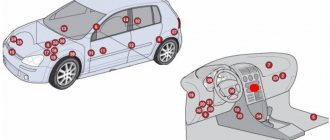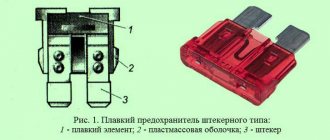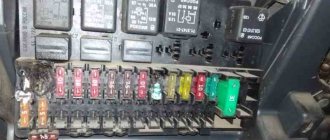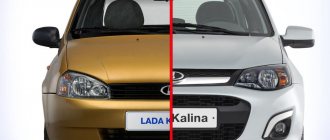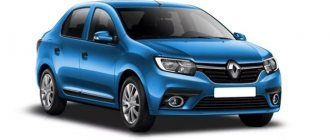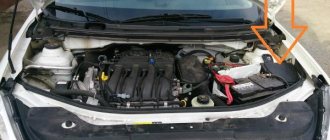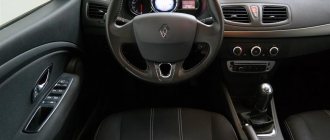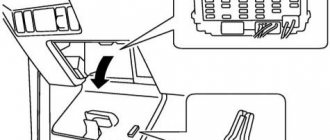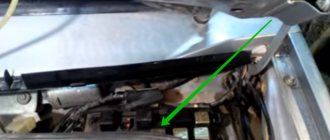Volkswagen Passat b5 is the 5th generation model of the Passat family. Produced in 1997, 1998, 1999, 2000, 2001, 2002, 2003, 2004 and 2005. After the 2001 update, it was popularly called Passat B5+ or Passat GP. In this article we will present a description of fuses and relays Volkswagen Passat B5 , complete block diagrams with the purpose of the elements and a photo of an example of execution. Separately, we highlight the fuse for the cigarette lighter and fuel pump.
The actual designation of fuses and relays may differ from those presented and depend on the configuration and year of manufacture of the vehicle.
Passat B5 fuse diagram
A description of all the design elements of the mounting block is given in the table. Salon part:
| Number | What is he responsible for? |
| 1 | Heated windshield washer nozzles |
| 2 | Power supply for turn signals |
| 3 | Control buttons for cruise control, climate control and steering wheel keys. |
| 4 | License plate light |
| 5 | Power supply, parking lights, navigation panel |
| 6 | Central locking and additional lamps |
| 7 | Speed sensor, ABS system, reversing lights |
| 8 | Phone power |
| 9 | Heated central locking and rear view mirrors |
| 10 | Headlight range control, standard radio |
| 11 | Automatic cruise control, power supply for tidy |
| 12 | Diagnostic devices |
| 13 | Feet |
| 14 | Interior lighting, anti-theft |
| 15 | Tidy, air conditioning and navigation controls. |
| 16 | ABS system power supply |
| 17 | Door lock heating power circuit |
| 18/19 | Driving lights |
| 20/21 | Low beam and headlight level control |
| 22/23 | Dimensions for each side respectively |
| 24 | Windshield wipers |
| 25 | Heater fan, air conditioner drive |
| 26 | Heated rear window power supply for exhaust recirculation system |
| 27 | Rear wiper |
| 28 | Fuel pump |
| 29 | ECM |
| 30 | Sunroof position drive |
| 31 | Cruise control, reverse gear and diagnostic connector output |
| 32 | ECM |
| 33 | Standard cigarette lighter |
| 34 | Injection and ignition control system |
| 35 | Tow hitch connector |
| 36 | PTF |
| 37 | Radio and telephone |
| 38 | Power supply for central locking, fuel tank lid opening drive, power windows |
| 39 | Emergency crew |
| 40 | Klaxon |
| 41 | ABS pump power supply or additional socket |
| 42 | Auxiliary cooling fan |
| 43 | S contact |
| 44 | Heated seats |
Separately, relay switches should be considered. In the R plane.
| Number | Description |
| 1 | Klaxon |
| 2 | Intermediate contact protection X |
| 3 | Wiper power supply |
| 4 | Fuel pump and glow plugs |
| 5/6 | Not used |
| 7/8 | Circuit breakers |
In the X plane.
| Number | Purpose |
| 1 | Radiator fan |
| 2 | Clutch |
| 3 | Air conditioning compressor magnetic clutch |
| 4 | Air conditioning power supply |
| 5 | Fuel pump for diesel engines |
| 6 | Interior lighting |
| 7 | Headlights |
| 8 | Glow plugs |
| 9 | Not used |
| 10 | PTF |
| 11 | On-board communication system |
| 12 | Starter power |
| 13 | Starter lock |
You also need to consider the power fuses mounted under the hood of the car.
| Number | Marking | Purpose |
| R1 | 167 | Engine control module |
| R2 | 373/100 | Secondary air intake pump |
| R3 | 429/219 or 53/411 | Power supply to the internal combustion engine control module or additional coolant pump |
| 1B | 116 | Injectors |
| 2B | Auxiliary coolant pump | |
| D | 130 | Secondary air pump |
| E | 115 | Plus ignition coils |
| F | 102 | ECU |
| G | 282 | Power plant electronics. |
Air conditioner fuse and relay
The system is divided into three parts. The power lines are powered from inserts 3 and 15 of the cabin unit. The control line runs from fusible protection No. 25.
Relay number 3 is responsible for the operation of the air conditioning compressor clutch and its direct activation. Relay number 4 is responsible for the remaining parts of the climate control.
Comfort block
The operation of the systems is controlled by fuse 38. In addition, it is supplied with No. 17.
Passat B5 cooling fan relay and fuse
The radiator fan is controlled by switch 1 of the cabin unit. This arrangement has remained unchanged since 1999.
Stove
Since 1995, the heater fuse has been installed in standard position 25. In some modifications, the installation location of the element may differ slightly.
Gasoline pump
The fuel fuse is mounted at position 28. The pump relay on gasoline and diesel engines is located in different places. Usually these are 4 and 5 respectively.
Finding a new relay will not be difficult. An article number is not required here - there are a large number of companies on the market that supply worthy analogues.
Passat B5 wiper fuse and relay: where are they located?
Windshield wiper repairs will need to begin by checking the corresponding inserts mounted at positions 24 and 27 for the front and rear of the car.
Starter fuse and relay
Since 1998, it has been installed at position 12. The standard arrangement is quite well thought out - the locking lever is mounted at number 13. Replacement of elements is required in case of their failure and is simple. The only snag is when the retractor needs to be serviced. The unit is mounted in the starter and to replace it you will need to disassemble the unit.
Cigarette lighter fuse
Passes through element 33 in the cabin. Since 2005, the manufacturer has also installed a rear cigarette lighter on cars. The unit also passes through the specified insert. Some users transfer elements or output them separately, trying to minimize the likelihood of breakdown when connecting powerful consumers.
Radio tape recorder
Standard acoustics are powered by fuse 10. When installing a more efficient system, the elements are often moved or installed separately. At the same time, music is connected directly from the battery.
Turn signals
The fuse is installed at position 39 in the on-board circuit. The switch is mounted separately and placed under the instrument panel. The average price ranges from 50 to 70 rubles.
Main relay Passat B5: where is it located
Installed in the engine compartment of the car. This arrangement has been relevant on B5 versions since 1995. The ignition coil is mounted slightly above the ECU.
Sound signal
The horn protective control element is installed at position 40. The relay is mounted at the first position in the block.
Window lifters
They are part of the on-board comfort system. You need to look for protective elements in points number 38.
Climate control
In most modifications of the machine there is no installation. The air conditioner takes its place and fully copes with its responsibilities.
VW Passat B5: glow plug relay
Located at number 8 in the interior relay panel.
Relay voltage regulator
Situated near the generator. This location is due to the design of the vehicle's electronic systems.
Trunk lock
Fuse 38 is responsible for the specified element, and also protects several related systems.
Backlight
No. 14 is responsible for interior lighting. Next, the system is protected by switch 6.
Wiper
The front and rear of the machine are protected by 24/27 fuse links respectively. There is only one relay here - No. 3.
Low beam
Power is supplied from fuses 20 and 21.
High beam
The system is also energy demanding. Each headlight is similarly powered by different fuses. Here these are inserts 18 and 19 for the left and right sides of the machine.
ABS
Due to the complexity of the design and the large amount of equipment, the ABS device units are powered directly from three fuses 7, 16 and 41.
Fog lights
Standard flashlights are powered by fuse 36, and both sides of the car are supplied at once. There is only one number 10 here.
Luke
Since 1997, this option began to be installed en masse on cars. In most configurations, insert 30 is responsible for the operation of the mechanism for opening and closing the panel.
Washer
The standard version is powered by part of the mounting block numbered 1. In modifications after 2001, the arrangement of the elements may differ slightly.
Dimensions
The lights are protected by inserts 22 and 23 for the left and right sides of the car. There is no relay here.
Charger
More interesting is the system for monitoring and limiting battery charging. All the necessary elements are placed on the wing of the vehicle, which allows minimizing the effort during their repair and maintenance.
Main relay block
It is located under the panel, on the driver's side, not far from the steering rack.
Scheme
Transcript R
| I | Horn relay |
| II | Intermediate relay contact X |
| III | Wiper relay |
| IV | Fuel pump relay Glow plug relay |
| V | Free |
| VI | Free |
| A | Fuse |
| B | Fuse |
Decoding Z
| 1 | Radiator Fan Relay (Air Conditioning) |
| 2 | Clutch relay |
| 3 | Magnetic Clutch Relay (Air Conditioning) |
| 4 | Air conditioner relay |
| 5 | Fuel pump relay on diesel engines |
| 6 | External lighting relay Taxi equipment |
| 7 | Headlight relay |
| 8 | Glow plug relay |
| 9 | Free |
| 10 | Fog light relay |
| 11 | Communication Relay |
| 12 | Starter relay |
| 13 | Starter Interlock Relay |
Additional relay block
It is installed on cars with an increased level of electrical equipment and is called eight-pin. Located behind the main relay box.
Photo - example
Scheme
Description
| 1 | Free |
| 2 | ABS/EDS/ESC relay |
| 3 | ABS/EDS/ESC relay |
| 4 | Fan relay 80 W Fan relay 300 W, 1 stage |
| 5 | Fan relay for maximum speed |
| 6 | Fan relay 300 W, 2nd stage |
| A | Fan fuse, 5A |
| B | Fan fuse, 30A |
| C | Hydraulic pump fuse, 50A |
Why is the windshield washer not working?
The causes of windshield washer malfunction can be divided into:
physical;
electric.
The physical reasons are based on the freezing of the liquid poured into the washer system. It is incorrect to believe that water freezes when the ambient temperature is below zero degrees Celsius.
Water can freeze even at positive ambient temperatures. While the car is moving, the thin tubes of the washer system and the nozzle are blown by air currents. At high humidity, due to physical processes, the tube is cooled, blown by high-speed air flows. If the ambient temperature is slightly positive, the temperature of the liquid in the tube (nozzle) may drop to minus values.
There is a lot of counterfeit on the Russian market. It’s a good idea to check the quality of the washer fluid (washer fluid) by placing it in a small plastic bottle in the freezer. The temperature in the freezer is approximately minus 18 degrees Celsius. There are times when the washer temperature is “-30 degrees”, and the liquid freezes in the freezer.
Washer failure can occur when water gets into the windshield nozzle (sprinkler). It is located at a positive angle to the horizon, therefore, if non-freezing liquid leaves it (this is possible due to insufficient tightness of the tubes and wear of the pump), rainwater and condensation after fog enter the free cavity. A microscopic drop is enough to block the washer fluid supply channel when frozen, and the system will be inoperable.
Video - how to defrost ice in the washer reservoir (some useful tips):
Physical malfunctions include loss of tightness of the membrane in the pump. Most electric washer pumps are of the membrane type. When the membrane wears out or is ruptured by frozen water, the pump drive remains operational, the pump “buzzes,” but does not pump liquid.
Another physical malfunction is damage to the integrity of the washer tubes.
Electrical faults include:
pump electric drive malfunction;
damage to electrical wiring;
failure of the fuses servicing the pump (often when the pump freezes);
Malfunction of the electronic body control unit.
How to repair?
The glass washer system is not complicated, and the faults are almost the same in most cases, so once you become familiar with them, you can carry out the repairs yourself.
Mechanical reasons
| Elimination method | |
| The fluid in the washer reservoir is frozen | It is necessary to drive the car into a room where the temperature is above zero, close the hood, start and warm up the engine thoroughly. Fill with new antifreeze fluid. |
| The hose came off | Put the hose back in place. |
| The motor shaft turned. You can hear the washer motor making noise, but no fluid comes out. | Replace the mechanism. |
| The hose through which water flows to the nozzles is pinched | Replace or straighten the hose. |
| The injectors are clogged | Clean or replace. |
Video “Improving front window washing”
This video tells you not only where the windshield washer system is located, but also how to make it work better.
Cars have special equipment for travel during bad weather associated with precipitation. The windshield of the VAZ 2107 is cleaned of water using movable brushes, and in case of contamination, the washer is activated. This device sprays a special liquid, it works simultaneously with the windshield wipers and removes dirt.
The equipment thus provides the necessary visibility for the driver and passengers. This device includes the following elements:
- Liquid reservoir.
- A pump that runs from the on-board network.
- Nozzles that blow a water jet onto the windshield of a car.
- Tubes connecting the tank to the actuators.
At the end of the summer season, the water in the system is replaced with non-freezing liquid, which will allow the system to be used in winter.
Electrical
Problems with electrical systems are rare. You can fix them yourself, but if in doubt, contact an experienced mechanic.
- The first place among the problems is the failure of the fuse. It’s easy to fix the problem - re-read the car’s operating instructions and use the symbols to find the required fuse and replace it with a new one.
- Another reason is that the washer motor does not work. The reason is oxidation of the terminals or their falling off. To eliminate the malfunction, you need to clean the contacts and reconnect the components if necessary.
- It also happens that the washer switch on the steering wheel does not work. You can check this using a multimeter. Connect the device to the motor terminals and check the voltage. If it is in order, but the mechanism does not work, most likely the switch is to blame. But a problem in the electrical wiring or lack of closure of the device relay cannot be ruled out. If it doesn’t work after replacing it yourself, you can’t do it without an experienced technician.
Windshield washer device
The process of troubleshooting a windshield washer begins with studying the design of the device and finding the cause of the problem.
- tank - is a special container that contains working fluid (usually it is located in the engine compartment, equipped with a filler neck and a cap);
- washer fluid level sensor - not present on all cars, but required if a glass washer and optics are combined;
- the pump is an important element due to which the working fluid is supplied at the required pressure;
- nozzles – necessary for spraying the washer composition, installed in pairs (the nozzle can be fan or jet);
